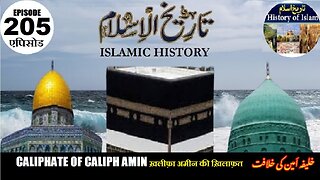Premium Only Content

History of Tomb of Hazrat Daniyal (AS) | تاریخ مقبرہ حضرت دانیال علیہ السلام
@islamichistory813 #SusaIran #ReligiousHeritage #HazratDaniyal
History of Tomb of Hazrat Daniyal (AS) in Susa, Iran
Asslamoalaikum sisters brothers friends and elders, Please be with us upto end of this video as we are describing islamic history of the Tomb of Hazrat Daniyal (AS) in Susa, Iran, as we unravel the mysteries and tales associated with this ancient site. Gain insights into the historical background and spiritual legacy of this revered shrine.
The Tomb of Prophet Daniel, is the traditional burial place of the biblical prophet Daniel. Various locations have been named for the site, but the tomb in Susa, Iran (Persia), is the most widely accepted, it being first mentioned by Benjamin of Tudela, who visited Asia between 1160 and 1163.
The Book of Daniel mentions that Daniel lived in Babylon and may have visited the palace of Susa?, Iran, but the place where he died is not specified; the tradition preserved among the Jews and Arabs is that he was buried in Susa. Today the Tomb of Daniel in Susa is a popular attraction among local Muslims and Iran's Jewish community alike. The earliest mention of Daniel's Tomb published in Europe is given by Benjamin of Tudela who visited Asia between 1160 and 1163.
According to Tabri, although not mentioned in Quran, Daniel (Daniyal) is considered by Muslims to have been a prophet. Reports of him being a prophet is from Jewish tradition, which bears his name and relates the episode of him spending time with Lions. Muslim traditions agree in stating that Daniel was buried at Susa (Zarih (grave) pictured here (peek inside), and a similar tradition was current among the Syriac writers. al-Baladhuri (ninth century) says that when the conqueror Abu Musa al-Ash'ari came to Susa in 638, he found the coffin of Daniel, which had been brought thither from Babylon in order to bring down rain during a period of drought. Abu Musa referred the matter to the calif Umar, who ordered the coffin to be buried, which was done by sinking it to the bottom of one of the streams nearby.
The main entrance (peek inside) to the tomb complex is richly adorned with glazed tiles and calligraphy of Quranic verses. The tomb presumed to be that of Daniel is located in the area, known as Shush-Daniel. However, a large portion of the current structure is actually a much later construction dated to the late nineteenth century, ca. 1871. Ibn Kathir also relates a tradition about people bringing out the bier of a pious man to pray for rain, during the reign of Khalifah Umar ibn al-Khattab, which was later buried in an un-marked grave.
During the Muslim conquest of Persia an Arab army invaded Khuzistan under the command of Abu Musa al-Ash'ari. After taking most of the smaller fortified towns the army captured Tustar in 642 before proceeding to besiege Susa. A place of military importance, it also held the tomb of the Christian prophet Daniel.
So friends, tomorow inshahAllah same time, will be described, History of Hazrat Habeel Mosque in Syria, West Bank, Palestine. Allah Hafiz
===============================
-
 12:21
12:21
ISLAMIC HISTORY
1 day agoIslamic History Episode 205 Caliphate of Caliph Amin ख़लीफ़ा अमीन की ख़िलाफ़त خلیفہ امین کی خلافت
4 -
 7:11
7:11
MudandMunitions
11 hours agoNY Legal, Still LETHAL! Colt M4 + Griffin Armament GPS3X Prism Sight! NIGHT SHOOT
2.55K3 -
 2:11
2:11
WildCreatures
2 days ago $0.32 earnedBrilliant Blue Hyacinth Macaw Eats Nuts With Impressive Dexterity
4.52K4 -
 29:45
29:45
DeVory Darkins
14 hours ago $4.35 earnedDemocrat Governor suffers EMBARRASSING LOSS to Trump as ICE takes Garcia into custody
8.99K53 -
 24:50
24:50
Bitcoin.com
14 hours agoEthereum hit an ATH this weekend | The Weekly Recap for Aug 25
265 -
 56:27
56:27
Actual Justice Warrior
14 hours agoAnti-White Celebrity DESTROYED On Jubilee
10.5K9 -
 19:44
19:44
itsSeanDaniel
1 day agoLiberal Karen INSTANTLY REGRETS Interrupting Putin's Right Hand Man
5.63K9 -
 1:20:38
1:20:38
BlaireWhite
2 days agoThe Dark Truth About UFOs: Why The Government Is Lying
9.78K11 -
 2:10:32
2:10:32
Side Scrollers Podcast
19 hours agoStreamer Nearly Beats A Man to Death on Stream + Twitch Viewership PLUMMETS + More | Side Scrollers
10.6K7 -
 13:09
13:09
Forrest Galante
1 day agoWildlife Expert Reacts To Deadly Australian Animal TikToks
88.1K14